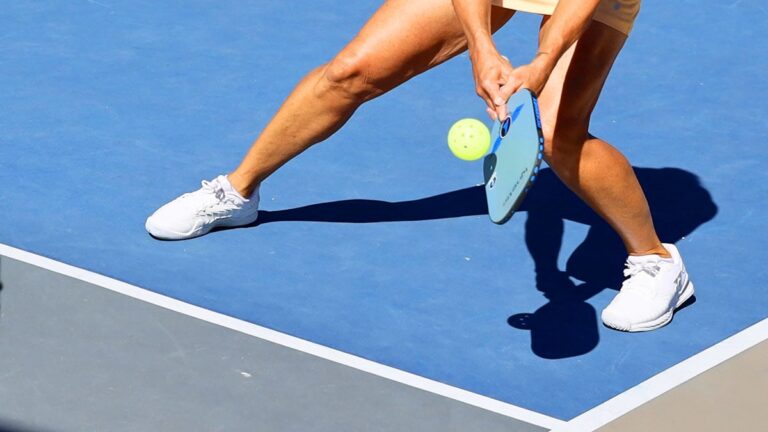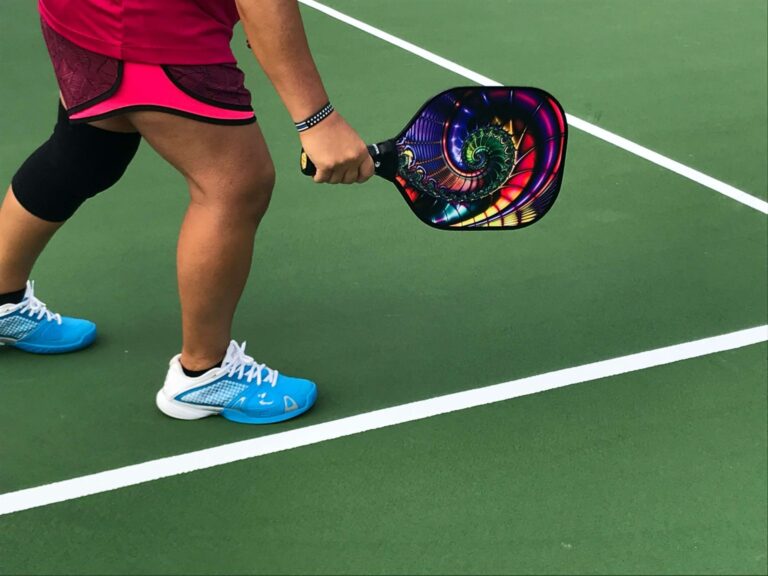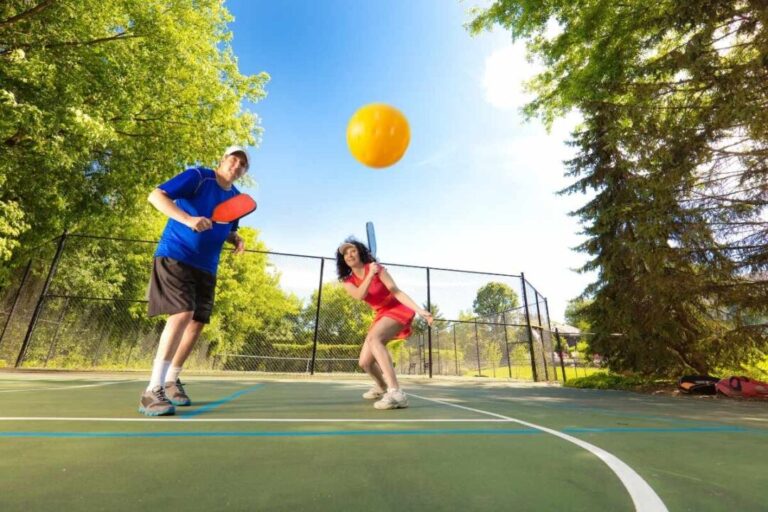Adding Slice to Your Shots in Pickleball: Strategic Advantage
Understanding the Basics of Slicing
Before mastering the slice, it’s vital to understand exactly what it is and how it differs from standard pickleball strokes. While topspin strokes are meant to arc over the net and bite after bouncing, a slice puts backspin on the ball, causing it to skid and stay maddeningly low.
The mechanics seem simple – instead of brushing up on the ball for topspin, you brush down across the back to impart that backspin. But properly executing this deceptive stroke takes precision:
- Forehand Slice: Brushing motion across the back of the ball with an angled paddle face, often using a continental or semi-western grip.
- Backhand Slice: Similar brushing action, often executed with a two-handed backhand grip to maintain control over the angled paddle face.
Mastering the technique is crucial, as the ball’s behavior after slicing differs dramatically from typical topspin shots. But when properly struck, those low-skidding slices can bamboozle even seasoned opponents.
The Tactical Advantages of Slicing
So beyond looking like a pickleball magician, why bother with slicing at all? As it turns out, the slice offers multiple strategic advantages to tilt the court in your favor:
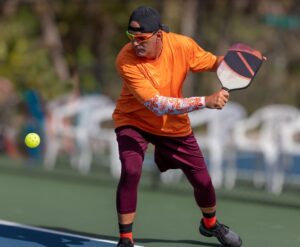
- Disrupting Rhythm & Timing: The slice’s low, skidding trajectory can completely throw off your opponent’s timing and footwork. Those bending, checking balls leave them stuck in the mud as easy putaways sail by.
- Controlling Pace & Spin: Need to suddenly reset the point or take heat off the ball? A well-placed slice diffuses power and spin, letting you regain control over the rally’s tempo.
- Positional Advantage: Deep, low-skidding slices push opponents off the baseline, giving you time to transition forward and seize the strategic non-volley zone.
But don’t become a one-trick pony – true mastery means integrating slices alongside other tactics to remain unpredictable. The ability to slice at just the right moments, however, gives you a powerful new weapon to dictate terms against any opponent.
Executing the Perfect Slice
Proper technique is the foundation for generating those maddeningly low-skidding slices. Here are the key fundamentals for slicing on both wings:
Forehand Slice
- Semi-open stance, front foot slightly ahead
- Upper body sideways to net, shoulders square to sideline
- Continental or semi-western grip to facilitate brushing
- Extend non-dominant arm for balance & alignment
- Brush down across back of ball with angled paddle face
- Full follow-through with paddle pointing to target
Backhand Slice
- Square stance, knees bent, weight evenly distributed
- Two-handed grip, non-dominant hand supports paddle
- Shoulders square, coil upper body on ball approach
- Brush back of ball, maintain firm wrist & smooth stroke
- Follow through across body, full release to target
| Common Mistakes | Corrections |
|---|---|
| Hitting ball too flat | Emphasize brushing action & angled paddle face |
| Over-swinging | Focus on control & spin over power |
| Poor footwork | Maintain balanced, athletic stance |
Avoid forcing the slice with excessive force. Focus instead on brushing the ball with the perfectly angled paddle face to impart that coveted backspin.
Advanced Slicing Techniques
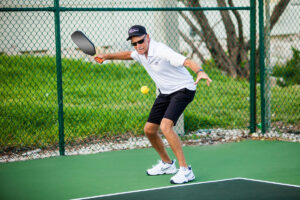
Once you’ve grooved the fundamentals, it’s time to level up your slicing skills with more advanced tactics:
Adding Overspin
For a real psychological warfare slice, exaggerate your brushing motion and laying into the ball to add revolutions of punishing overspin. These slices will skid, kick violently, and leave your opponent clueless as the ball dances unpredictably.
Slice Combinations
- Slice deep to push opponent back, then strike cross-court
- Slice short to induce attack, then execute passing shot
- Disguise slice as setup for putaway volley or offensive lob
The key is blending slices unpredictably with other tactics. You’ll keep opponents endlessly off-balance and uncertain of what shot is coming next.
Situational Slicing
- Serves/Returns: Neutralize spin with a slicing return
- Doubles: Create confusion between opponents with low, skidding cross-court slices
- Style Adjustments: Slice deep vs. net rushers; disrupt cadence vs. steady baseliners
Keen slicers identify moments when the slice gives them the biggest tactical advantage and capitalize accordingly.
Drills and Practices
Integrating the slice into your game takes diligent practice – both in developing the stroke itself and recognizing opportune situations to unleash it. Try these drills:
Here’s more content continuing the drills and practice section:
Wall Work
The simplest way to groove your slicing technique is through wall drills. Start up close and focus solely on brushing the ball with backspin to induce that signature low, skidding bounce off the wall. Gradually increase the distance as you improve spin and control.
Cross-Court Targets
With a partner or ball machine, set up targets or cones in the cross-court corners and practice hitting sliced shots to hit each one. This drill reinforces the side spin needed to push the ball out wide while improving placement and accuracy.
Game Scenarios
The ultimate test is incorporating slices into live game situations during practice matches or games with friends:
-
- Reset Point: Use a slice to diffuse pace and take control.
- Defensive Position: Slice to push opponent back when retreating.
- Disrupt Cadence: Slice to throw off timing and rhythm against steady baseliners.
- Passing Shot Setup: Slice short to bait them forward, then fire a passing winner.
Really focus on identifying and capitalizing on opportune slicing moments as they emerge during points. The more you practice situational slicing, the more it becomes an instinctive, tactical weapon.
Avoiding Common Pitfalls
While integrating the slice is a huge asset, there are some common pitfalls to avoid:
Overreliance
As potent as the slice can be, an overreliance on it makes you one-dimensional and predictable. Seasoned opponents will quickly catch on and start exploiting your tendencies. The key is to blend slicing seamlessly with other tactics, always keeping them off-balance.
Adapting Your Strategy
Similarly, be prepared to adjust your slice usage based on your opponent’s abilities and responses. If they start neutralizing your slices effectively, it’s time to reset your overall strategy and look for other targeted opportunities.
Technical Lapses
- Poor Brushing Action: Ensuring a crisp, angled brush off the back of the ball.
- Lack of Spin: Hitting too flat or “pushing” the slice without imparting backspin.
- Depth Control: Finding the ideal depth to keep opponent pinned back.
Consistent practice, adjustments based on feedback, and a commitment to mastering the finer points will help avoid these pitfalls.
Conclusion
In the fast-paced, highly competitive world of pickleball, the slice shot is a true game-changer capable of snatching victory from the jaws of defeat. Armed with the ability to disrupt, reset, and dictate terms through strategically deployed slices, you elevate your skills to an entirely new level.
Yet as with any great weapon, true mastery of the slice lies in understanding its role within a larger, unified tactical approach. The slice is a powerful tool, but one that must be wielded judiciously and blended creatively with other techniques. Those who can integrate the slice as a key piece of their overall strategic puzzle become maddeningly unpredictable opponents.
So embrace the slice in all its backspin-laden glory! Through dedicated practice, a keen tactical mind, and a willingness to confound your opponents, you can harness this deceptive shot and scatter their hopes like the skidding ball off your perfectly angled paddle face.


